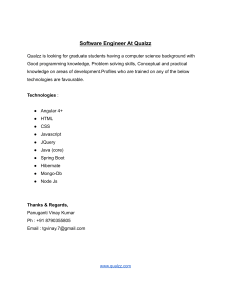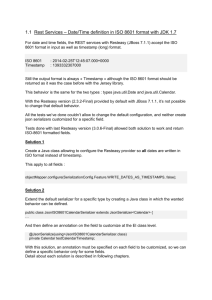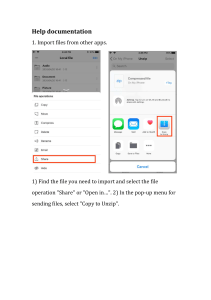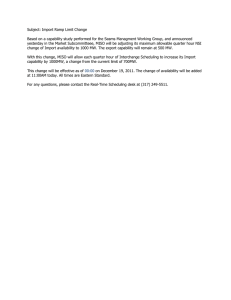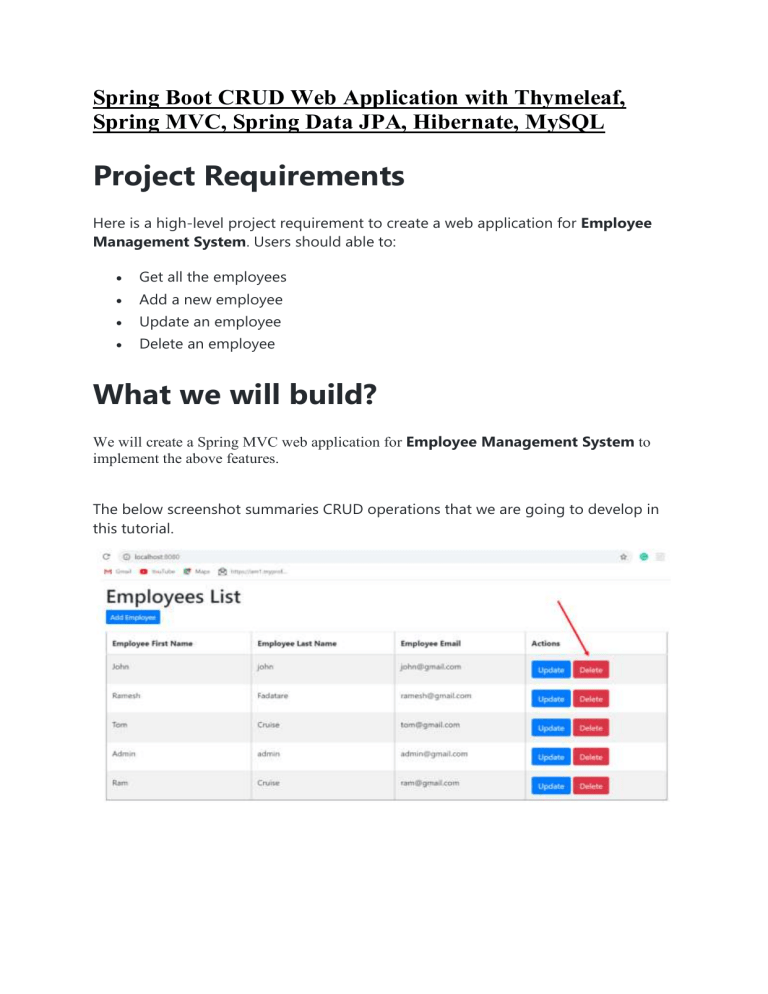
Spring Boot CRUD Web Application with Thymeleaf,
Spring MVC, Spring Data JPA, Hibernate, MySQL
Project Requirements
Here is a high-level project requirement to create a web application for Employee
Management System. Users should able to:
Get all the employees
Add a new employee
Update an employee
Delete an employee
What we will build?
We will create a Spring MVC web application for Employee Management System to
implement the above features.
The below screenshot summaries CRUD operations that we are going to develop in
this tutorial.
Application Flow
The below diagram shows the application flow of our Spring MVC web application
with Thymeleaf:
Tools and technologies used
IDE - Eclipse / STS
Spring Boot 2.2.6+
Spring Framework 5.2.5+
Maven 3.2 +
Java 8
Spring Data JPA ( Hibernate)
Thymeleaf
1. Create Spring Boot Project
There are many ways to create a Spring Boot application. You can refer below articles
to create a Spring Boot application.
>> Create Spring Boot Project With Spring Initializer
>> Create Spring Boot Project in Spring Tool Suite [STS]
2. Maven Dependencies
<?xml version="1.0" encoding="UTF-8"?>
<project
xmlns="http://maven.apache.org/POM/4.0.0"
xmlns:xsi="http://www.w3.org/2001/XMLSchema-instance"
xsi:schemaLocation="http://maven.apache.org/POM/4.0.0
https://maven.apache.org/xsd/maven-4.0.0.xsd">
<modelVersion>4.0.0</modelVersion>
<parent>
<groupId>org.springframework.boot</groupId>
<artifactId>spring-boot-starter-parent</artifactId>
<version>2.2.7.RELEASE</version>
<relativePath/>
<!-- lookup parent from repository -->
</parent>
<groupId>net.javaguides</groupId>
<artifactId>springboot-thymeleaf-crud-web-app</artifactId>
<version>0.0.1-SNAPSHOT</version>
<name>springboot-thymeleaf-crud-web-app</name>
<description>Demo project for Spring Boot and thymeleaf</description>
<properties>
<java.version>1.8</java.version>
</properties>
<dependencies>
<dependency>
<groupId>org.springframework.boot</groupId>
<artifactId>spring-boot-starter-data-jpa</artifactId>
</dependency>
<dependency>
<groupId>org.springframework.boot</groupId>
<artifactId>spring-boot-starter-thymeleaf</artifactId>
</dependency>
<dependency>
<groupId>org.springframework.boot</groupId>
<artifactId>spring-boot-starter-web</artifactId>
</dependency>
<dependency>
<groupId>org.springframework.boot</groupId>
<artifactId>spring-boot-devtools</artifactId>
<scope>runtime</scope>
<optional>true</optional>
</dependency>
<dependency>
<groupId>mysql</groupId>
<artifactId>mysql-connector-java</artifactId>
<scope>runtime</scope>
</dependency>
<dependency>
<groupId>org.springframework.boot</groupId>
<artifactId>spring-boot-starter-test</artifactId>
<scope>test</scope>
<exclusions>
<exclusion>
<groupId>org.junit.vintage</groupId>
<artifactId>junit-vintage-engine</artifactId>
</exclusion>
</exclusions>
</dependency>
</dependencies>
<build>
<plugins>
<plugin>
<groupId>org.springframework.boot</groupId>
<artifactId>spring-boot-maven-plugin</artifactId>
</plugin>
</plugins>
</build>
</project>
3. Project Structure
4. Configure and Setup MySQL Database
Create a database with the name "demo" in the MySQL database server.
We’ll need to configure MySQL database URL, username, and password so that
Spring can establish a connection with the database on startup.
Open application.properties and add following MySQL database configuration:
# DATASOURCE (DataSourceAutoConfiguration & DataSourceProperties)
spring.datasource.url=jdbc:mysql://localhost:3306/demo?useSSL=false&serverTimezone
=UTC&useLegacyDatetimeCode=false
spring.datasource.username=root
spring.datasource.password=root
# Hibernate
# The SQL dialect makes Hibernate generate better SQL for the chosen database
spring.jpa.properties.hibernate.dialect =
org.hibernate.dialect.MySQL5InnoDBDialect
# Hibernate ddl auto (create, create-drop, validate, update)
spring.jpa.hibernate.ddl-auto = update
logging.level.org.hibernate.SQL=DEBUG
logging.level.org.hibernate.type=TRACE
Make sure that you change
the spring.datasource.username and spring.datasource.password properties as
per your MySQL installation.
The spring.jpa.hibernate.ddl-auto = update property makes sure that the
database tables and the domain models in your application are in sync. Whenever
you change the domain model, hibernate will automatically update the mapped table
in the database when you restart the application.
I have also specified the log levels for hibernate so that we can debug the SQL
queries executed by hibernate.
5. Model Layer - Create JPA Entity - Employee.java
Let's create Employee.java class under "net.javaguides.springboot.model" package
and add following content to it:
package net.javaguides.springboot.model;
import
import
import
import
import
import
javax.persistence.Column;
javax.persistence.Entity;
javax.persistence.GeneratedValue;
javax.persistence.GenerationType;
javax.persistence.Id;
javax.persistence.Table;
@Entity
@Table(name = "employees")
public class Employee {
@Id
@GeneratedValue(strategy = GenerationType.IDENTITY)
private long id;
@Column(name = "first_name")
private String firstName;
@Column(name = "last_name")
private String lastName;
@Column(name = "email")
private String email;
public long getId() {
return id;
}
public void setId(long id) {
this.id = id;
}
public String getFirstName() {
return firstName;
}
public void setFirstName(String firstName) {
this.firstName = firstName;
}
public String getLastName() {
return lastName;
}
public void setLastName(String lastName) {
this.lastName = lastName;
}
public String getEmail() {
return email;
}
public void setEmail(String email) {
this.email = email;
}
}
6. Repository Layer - EmployeeRepository.java
Create a EmployeeRepository interface under "net.javaguides.springboot.repository"
package and add the following content to it:
package net.javaguides.springboot.repository;
import org.springframework.data.jpa.repository.JpaRepository;
import org.springframework.stereotype.Repository;
import net.javaguides.springboot.model.Employee;
@Repository
public interface EmployeeRepository extends JpaRepository<Employee, Long>{
}
7. Service Layer
7.1 EmployeeService.java interface
The complete code:
package net.javaguides.springboot.service;
import java.util.List;
import net.javaguides.springboot.model.Employee;
public interface EmployeeService {
List < Employee > getAllEmployees();
void saveEmployee(Employee employee);
Employee getEmployeeById(long id);
void deleteEmployeeById(long id);
}
7.2. EmployeeServiceImpl class
The complete code:
package net.javaguides.springboot.service;
import java.util.List;
import java.util.Optional;
import org.springframework.beans.factory.annotation.Autowired;
import org.springframework.stereotype.Service;
import net.javaguides.springboot.model.Employee;
import net.javaguides.springboot.repository.EmployeeRepository;
@Service
public class EmployeeServiceImpl implements EmployeeService {
@Autowired
private EmployeeRepository employeeRepository;
@Override
public List < Employee > getAllEmployees() {
return employeeRepository.findAll();
}
@Override
public void saveEmployee(Employee employee) {
this.employeeRepository.save(employee);
}
@Override
public Employee getEmployeeById(long id) {
Optional < Employee > optional = employeeRepository.findById(id);
Employee employee = null;
if (optional.isPresent()) {
employee = optional.get();
} else {
throw new RuntimeException(" Employee not found for id :: " + id);
}
return employee;
}
@Override
public void deleteEmployeeById(long id) {
this.employeeRepository.deleteById(id);
}
}
8. Controller Layer - EmployeeController.java
The complete code:
package net.javaguides.springboot.controller;
import
import
import
import
import
import
import
org.springframework.beans.factory.annotation.Autowired;
org.springframework.stereotype.Controller;
org.springframework.ui.Model;
org.springframework.web.bind.annotation.GetMapping;
org.springframework.web.bind.annotation.ModelAttribute;
org.springframework.web.bind.annotation.PathVariable;
org.springframework.web.bind.annotation.PostMapping;
import net.javaguides.springboot.model.Employee;
import net.javaguides.springboot.service.EmployeeService;
@Controller
public class EmployeeController {
@Autowired
private EmployeeService employeeService;
// display list of employees
@GetMapping("/")
public String viewHomePage(Model model) {
model.addAttribute("listEmployees", employeeService.getAllEmployees());
return "index";
}
@GetMapping("/showNewEmployeeForm")
public String showNewEmployeeForm(Model model) {
// create model attribute to bind form data
Employee employee = new Employee();
model.addAttribute("employee", employee);
return "new_employee";
}
@PostMapping("/saveEmployee")
public String saveEmployee(@ModelAttribute("employee") Employee employee) {
// save employee to database
employeeService.saveEmployee(employee);
return "redirect:/";
}
@GetMapping("/showFormForUpdate/{id}")
public String showFormForUpdate(@PathVariable(value = "id") long id, Model
model) {
// get employee from the service
Employee employee = employeeService.getEmployeeById(id);
// set employee as a model attribute to pre-populate the form
model.addAttribute("employee", employee);
return "update_employee";
}
@GetMapping("/deleteEmployee/{id}")
public String deleteEmployee(@PathVariable(value = "id") long id) {
// call delete employee method
this.employeeService.deleteEmployeeById(id);
return "redirect:/";
}
}
9. View Layer
9.1 index.html
Create new index.html file under "resources/templates" folder and add the following
content to it:
<!DOCTYPE html>
<html lang="en" xmlns:th="http://www.thymeleaf.org">
<head>
<meta charset="ISO-8859-1">
<title>Employee Management System</title>
<link rel="stylesheet"
href="https://stackpath.bootstrapcdn.com/bootstrap/4.1.3/css/bootstrap.min.css"
integrity="sha384MCw98/SFnGE8fJT3GXwEOngsV7Zt27NXFoaoApmYm81iuXoPkFOJwJ8ERdknLPMO"
crossorigin="anonymous">
</head>
<body>
<div class="container my-2">
<h1>Employees List</h1>
<a th:href="@{/showNewEmployeeForm}" class="btn btn-primary btn-sm mb-3">
Add Employee </a>
<table border="1" class="table table-striped table-responsive-md">
<thead>
<tr>
<th>Employee First Name</th>
<th>Employee Last Name</th>
<th>Employee Email</th>
<th> Actions </th>
</tr>
</thead>
<tbody>
<tr th:each="employee : ${listEmployees}">
<td th:text="${employee.firstName}"></td>
<td th:text="${employee.lastName}"></td>
<td th:text="${employee.email}"></td>
<td> <a
th:href="@{/showFormForUpdate/{id}(id=${employee.id})}" class="btn btnprimary">Update</a>
<a th:href="@{/deleteEmployee/{id}(id=${employee.id})}"
class="btn btn-danger">Delete</a>
</td>
</tr>
</tbody>
</table>
</div>
</body>
</html>
9.2 new_employee.html
Create new new_employee.html file under "resources/templates" folder and add the
following content to it:
<!DOCTYPE html>
<html lang="en" xmlns:th="http://www.thymeleaf.org">
<head>
<meta charset="ISO-8859-1">
<title>Employee Management System</title>
<link rel="stylesheet"
href="https://stackpath.bootstrapcdn.com/bootstrap/4.1.3/css/bootstrap.min.css"
integrity="sha384MCw98/SFnGE8fJT3GXwEOngsV7Zt27NXFoaoApmYm81iuXoPkFOJwJ8ERdknLPMO"
crossorigin="anonymous">
</head>
<body>
<div class="container">
<h1>Employee Management System</h1>
<hr>
<h2>Save Employee</h2>
<form action="#" th:action="@{/saveEmployee}" th:object="${employee}"
method="POST">
<input type="text" th:field="*{firstName}" placeholder="Employee First
Name" class="form-control mb-4 col-4">
<input type="text" th:field="*{lastName}" placeholder="Employee Last
Name" class="form-control mb-4 col-4">
<input type="text" th:field="*{email}" placeholder="Employee Email"
class="form-control mb-4 col-4">
<button type="submit" class="btn btn-info col-2"> Save
Employee</button>
</form>
<hr>
<a th:href="@{/}"> Back to Employee List</a>
</div>
</body>
</html>
9.3 update_employee.html
Create update_employee.html file under "resources/templates" folder and add the
following content to it:
<!DOCTYPE html>
<html lang="en" xmlns:th="http://www.thymeleaf.org">
<head>
<meta charset="ISO-8859-1">
<title>Employee Management System</title>
<link rel="stylesheet"
href="https://stackpath.bootstrapcdn.com/bootstrap/4.1.3/css/bootstrap.min.css"
integrity="sha384MCw98/SFnGE8fJT3GXwEOngsV7Zt27NXFoaoApmYm81iuXoPkFOJwJ8ERdknLPMO"
crossorigin="anonymous">
</head>
<body>
<div class="container">
<h1>Employee Management System</h1>
<hr>
<h2>Update Employee</h2>
<form action="#" th:action="@{/saveEmployee}" th:object="${employee}"
method="POST">
<!-- Add hidden form field to handle update -->
<input type="hidden" th:field="*{id}" />
<input type="text" th:field="*{firstName}" class="form-control mb-4
col-4">
<input type="text" th:field="*{lastName}" class="form-control mb-4
col-4">
<input type="text" th:field="*{email}" class="form-control mb-4 col4">
<button type="submit" class="btn btn-info col-2"> Update
Employee</button>
</form>
<hr>
<a th:href="@{/}"> Back to Employee List</a>
</div>
</body>
</html>
10. Run Spring application and demo
Run spring boot application with the following command:
$ mvn spring-boot:run
Demo
List Employees Page
Update Employee Page
Add Employee Page
